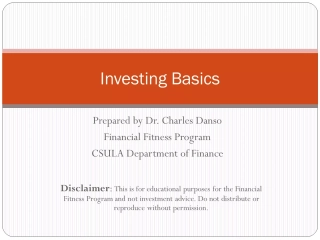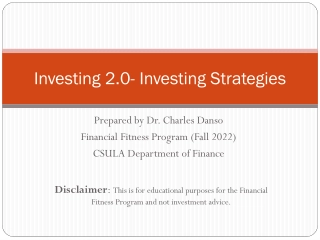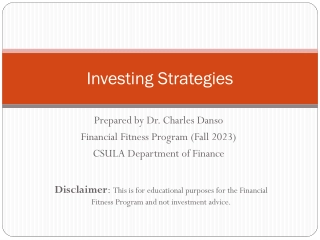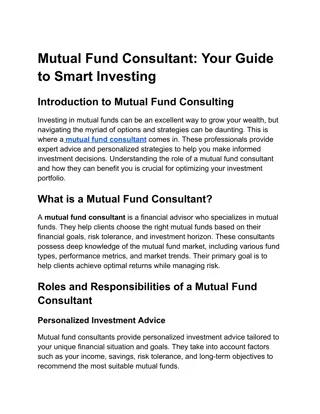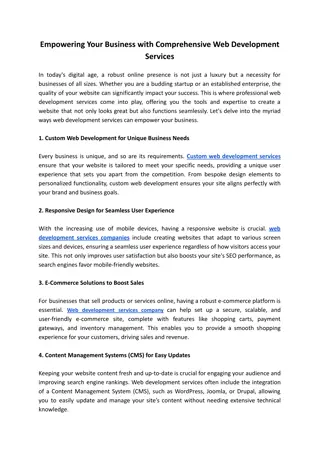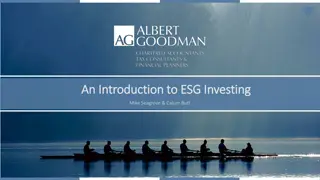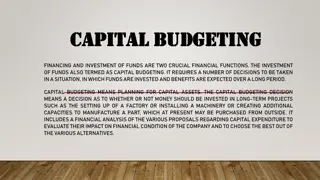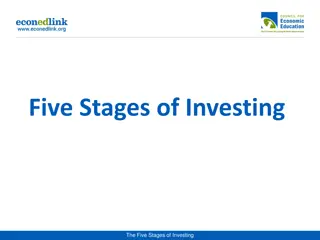Understanding Investing
Delve into the world of investing, from defining the concept to exploring the importance of starting early. Learn about compounding interest, risk tolerance, and the benefits of different types of investments for financial growth and security, especially in the context of retirement planning.
Download Presentation

Please find below an Image/Link to download the presentation.
The content on the website is provided AS IS for your information and personal use only. It may not be sold, licensed, or shared on other websites without obtaining consent from the author. Download presentation by click this link. If you encounter any issues during the download, it is possible that the publisher has removed the file from their server.
E N D
Presentation Transcript
INVESTING 101 How To Make Your Money Work For You
Subject Layout What is investing? How does it work? (Compounding) Risk Tolerance: Know Yourself Types of Investments Portfolios and Diversification
What is Investing? Definition: The act of committing money or capital to an endeavor with the expectation of obtaining an additional income or profit. Why is this important? Letting your money work for you Investing is NOT gambling Why might it be important for you to invest?
Why Invest? Retirement would you like to retire early? At all? At your current lifestyle? Pension programs - employer puts money into a pool of funds that is invested on the employee s behalf Becoming a thing of the past Social security government program paid for by income tax and given to retirees /disabled funds under pressure due to aging population in the US What money can you depend on for retirement?
Why Invest? Investing money now allows financial flexibility for your future The earlier you start investing, the easier it will be to establish a large amount of money
How does investing work? Compounding 101 Compound interest - interest calculated on the initial principal and also on the accumulated interest of previous periods Allows you to make money on the money you ve made For example, you invest $100.00 at 5% interest, compounded yearly. After the first year, you have $105.00 (100*1.05). In the second year, you will have $110.25 (105*1.05). Because of compound interest, you have made $5.25 in interest, compared to $5.00 in the first year Formula: ?[(1 + ?)?], where P = principal, i = interest rate, n = number of compounding periods
Time and Compounding The more time you have, the more money you can make Example: Jim invests $15,000.00 at age 20, and Sally invests $15,000.00 at age 35. They both earn 5% interest, compounded yearly, and both plan on taking this money out at age 65. Jim earns ?[(1 + ?)?], 15000[(1 + .05)^(45)] = $134,775.12 Sally earns 15000[(1 + .05)^(30)] = $64,829.14 That is $69,945.98 difference!!!
Time and Compounding Compounding accelerates your earning power Compounding maximizes your earing potential of your investments You must leave the initial investment and interest earned alone for this to happen
Knowing Yourself: Risk Tolerance A measure of how much risk you can handle as an investor Factors which determine your risk tolerance? Amount of money you have to lose Your time frame Emotional ability to handle risk Determines what kinds of investments you should pursue There is no right or wrong way to invest
Types of Investments Bonds Stocks Mutual Funds Alternative Investments
Types of Investments - Bonds Definition: an interest-bearing security that obligates the issuer to pay the bondholder a specified sum of money, usually at specific intervals (known as a coupon), and to repay the principal amount of the loan at maturity Wait, what? A bond is basically a loan given by you to another entity which is paid back with interest over the life of the bond. Interest is paid throughout the bond life Principal is paid back at the end of the life of the bond
Types of Investments - Bonds For Example: Your hometown decides to issue municipal bonds with a $100 face value to be paid back in ten years. This bond will pay 2.5% per year. $100 * .025 = $2.50 $2.50 * 10 = $25.00 Total paid back to you: $100 + $25 = $125
Types of Investments - Bonds There are many different types of bonds: U.S. Treasury Bonds issued by the U.S. government, considered a safe investment Agency Bonds issued by agencies of the U.S. government or government sponsored enterprises Municipal Bonds issued by states, cities, counties, etc. to fund public projects Corporate Bonds issued by corporations High Yield Bonds issued by entities that have a low investment grade (they have a weaker ability to pay back the bond); generally results in a higher interest rate and higher yields
Types of Investments - Bonds Bond Ratings Definition a grade given to a particular bond that indicates its credit quality Range from AAA (the highest rating) to C or D (called junk bonds, the lowest ratings) Private, independent services provide ratings, so indications may vary for the same rating Major rating agencies in the U.S.: Moody s, Standard & Poor s, and Fitch
Types of Investments - Bonds Bond Rating Grade Risk Moody\ s S&P/Fitch Aaa AAA Investment Highest Quality Aa AA Investment Strong Quality A A Investment Strong Baa BBB Investment Medium Grade Ba, B BB, B Junk Speculative Caa/Ca/C CCC/CC/C Junk Highly Speculative C D Junk In Default
Types of Investments - Bonds Bonds are generally a very safe investment. What is the drawback? Payback on bonds is usually lower than other types of investments Bonds are a great investment for people who are risk averse An investor who prefers an investment with lower risk. Pay attention to grades; bonds can be as risky/riskier than stocks
Types of Investments - Stocks Definition: A term used to describe the ownership certificates of any company Also called: equities, shares Stocks are volatile; their value fluctuates frequently (on a daily basis)
Types of Investments - Stocks Why do companies issue stocks? To raise money Sell part of the company (AKA issuing stocks) equity financing Do not have to pay money back or make interest payments Shareholders make money when the stock is worth more than they paid
Types of Investments - Stocks Why do stocks make money? You (as an owner) are entitled to a portion of the company s profits Paid out in the form of dividends A sum of money paid regularly by a company to its shareholders out of profits (or reserves). Where is the risk? If the company goes bankrupt, there are no assets to claim
Types of Investments - Stocks Risk Shareholders are not guaranteed any return if the company goes bankrupt No guarantee that shareholders will receive dividend payments With no dividends, investors make money only through an increase in stock price The bright side? Stocks generally outperform other investments due to their higher risk Historically, stocks average 10-12% returns
Types of Investments - Stocks Two Main Types of Stock: Common and Preferred Common stock most commonly referred to Represent ownership in a company and claim on profits One vote per share Higher Yields
Types of Investments - Stocks Preferred Stock Guaranteed a fixed dividend In the event of liquidation, preferred shareholders are paid first Do not have the same voting rights as common stockholders May be callable (company can purchase shares from shareholders at any time for any reason)
Types of Investments - Stocks Companies can also customize different classes of stock in any way they would like Reasons for this may include wanting voting power to remain with certain people Traditionally noted as Class A, Class B, etc.
Types of Investments - Stocks Most stocks are traded on exchanges Physical trades are carried out on a trading floor Virtual composed of a network of computers Purpose of the stock market facilitate the exchange of securities between buyers and sellers Reduces risk of investing because it brings buyers and sellers together
Types of Investments - Stocks Different markets: Primary and Secondary Primary market securities are created and stocks are initially issued through IPO Secondary Market investors trade previously-issued stocks What people refer to when talking about the stock market Trading of a company s stock does not directly involve that company Examples: NYSE, Nasdaq, AMEX
Types of Investments - Stocks Why do stock prices change? Stocks are volatile and can change in price rapidly Fundamentally, supply and demand determine the price of stocks Earnings predominately affect investor evaluation of stocks, but there are other factors There is no one theory that can explain stock prices
Types of Investments - Stocks There are two ways to buy stocks: Through a brokerage Most common Full-service brokers - expensive but manage your account Discount brokerages - less expensive and provide less assistance DRIPs & DIPs Dividend reinvestment plans (DRIPs) and direct investment plans (DIPs) allow shareholders to purchase stock directly from the company
Types of Investments - Stocks Buying stocks through a brokerage: Step 1: Obtain a stock quote. This shows the bid (buy) price and the offer or ask (sell) price. Step 2: If you are interested in buying a stock, you make a bid. If you are interesting in selling a stock, you would submit an offer or an ask. Step 3: When a bid and offer match, a trade occurs.
Types of Investments - Stocks How to read a stock table or stock quote Week high and low price: highest and lowest prices stock has traded at in 52 weeks Ticker: Alphabetic name unique to the stock that identifies it on exchanges Company name and type of stock: with no symbols following company name, stock is common stock.
Types of Investments - Stocks How to read a stock table or stock quote Price to Earning Ratio: Current stock price divided by earnings per share from the last four quarters Dividend per share: Annual dividend payment per share Dividend Yield: Annual dividends per share divided by price per share
Types of Investments - Stocks How to read a stock table or stock quote Total number of shares traded for the day (in hundreds) Close last price traded at upon market closing for the day Net change change in stock price in dollars from previous day s close Daily High and Low: range of prices that stock has traded at throughout the day
Types of Investments - Stocks How to value a stock: very complicated and differs from person to person. Four principles impact value: Supply and demand determine the price of stocks from moment to moment Do not compare the value of individual stocks; rather, compare values of companies Multiply the value of a stock by the shares outstanding to Earnings are a major factor, but they are not the only factor There is no one theory that can explain how stocks are valued.
Types of Investments Mutual Funds What is a mutual fund? An investment vehicle that consists of a pool of funds contributed by many investors in order to invest in stocks, bonds, and other assets. These funds are managed by money managers
Types of Investments Mutual Funds Advantage of mutual funds: Give small investors access to professional investment help by allowing them to invest in diversified portfolios Disadvantage of mutual funds Fees, which can limit profit
Types of Investments Mutual Funds Pooled Funds: Aggregated investment from many individuals Examples: mutual funds, pension funds Advantages: Economies of scale - lower trading costs and professional management Disadvantages: management fees/capital gains are spread evenly among investors, what is best for the group may not be what is best for an individual
Types of Investments - ETFs Definition: exchange-traded funds (ETFs) are an alternative to mutual funds that allow for more flexibility. Trade on exchanges Priced and available for trading throughout the business day Generally have a slightly lower expense ratio than their mutual fund equal
Types of Investments - Alternative Several other types of investment vehicles available Options, futures, FOREX, commodities, etc. Usually very high risk and require specialized knowledge to be successful First, create a good financial platform in lower-risk investments
Portfolios and Diversification Important for long-term goals such as retirement Portfolio: a conglomerate of different financial assets which balances risk and return Diversification: a risk management tool that mixes a large amount of investment mediums within a portfolio Portfolios and diversification go hand-in-hand
Portfolios What do portfolios include? Any asset you own: tangible assets, equities, bonds, etc. Think of like a pie chart The asset mix should meet your risk tolerance and time horizon
Portfolios Aggressive investment strategies: aim to make the highest returns Investor should have high risk tolerance Investor should have a longer time horizon Generally have many equities Aggressive Investment Portfolio Mix Bonds 15% Fixed Income 10% 70-85% Equities 5-10% Fixed Income 5-15% Bonds Equities 75%
Portfolios Conservative investment strategies: puts safety over returns Investors should be risk averse Investors should have a shorter time horizon Consists mainly of cash and cash equivalents Goal is to combat inflation to protect the value of the portfolio Conservative Investment Portfolio Mix 10% 70-75% Fixed Income Securities 15% 15-20% Equities 75% 5-15% Cash and Cash Equivalents
Portfolios Moderately Aggressive Portfolio: Balances risk and return Investor should have an average risk tolerance Investor should have a longer time horizon Moderate amounts of equities, bonds, and cash and cash equivalents Moderately Aggressive Portfolio Mix 10% 50-55% Equities 35-40% Fixed Income Securities 35% 55% 5-10% Cash and Cash Equivalents
Diversification Two categories of risk affect investments: Systematic Risk: inherent to a market that is unpredictable; impossible to avoid The Great Recession Measured by a security s beta: >1 - more risk than the market <1 - less risk than the market Unsystematic Risk: company- or industry- specific risk inherent in all investments Reduced by DIVERSIFICATION
Diversification Using diversification to combat unsystematic risk Portfolios include investments in unrelated industries EXAMPLE: as an employee of United Airlines, you receive company stock every year. You realize that your portfolio is susceptible to risk if the airline company fails. What investments might you use to balance this risk? Avoid investing in the airline industry or companies that do business with airline industries. Instead, invest in healthcare, clothing companies, or other, non-related industries.
Diversification There are a lot of complicated ratios and opinions that allow for portfolios to be diversified Understanding the basics of diversification is enough to invest safely
Conclusion Compounding allows your money to make money There is no wrong way to invest Risk tolerance is a measure of how much risk you can withstand as an investor, and should be considered when choosing an investment
Conclusion Bonds: a loan paid by you to a company that will be paid back with interest Stocks: ownership in a company and rise in value with the company Mutual funds: shared access of diversified investment mediums, may include fees Portfolios should be diversified to combat risk
References Investopedia Staff. "Investing 101: A Tutorial For Beginner Investors." Investopedia. Investopedia, 30 Mar. 2017. Web. 17 Apr. 2017. Hayes, Adam. "Bonds." Investopedia. Investopedia, 11 Apr. 2017. Web. 17 Apr. 2017. Investopedia Staff. "Stock." Investopedia. Investopedia, 30 Dec. 2015. Web. 17 Apr. 2017. Investopedia Staff. "Mutual Fund." Investopedia. Investopedia, 28 Mar. 2017. Web. 17 Apr. 2017. Investopedia Staff. "Diversification." Investopedia. Investopedia, 08 Jan. 2015. Web. 17 Apr. 2017.


